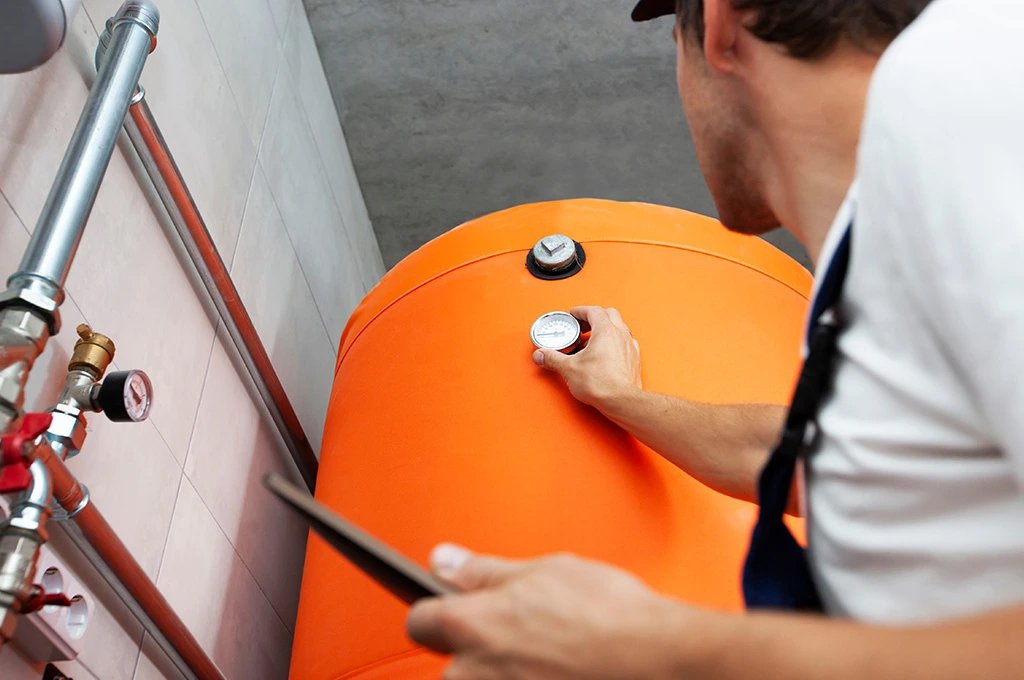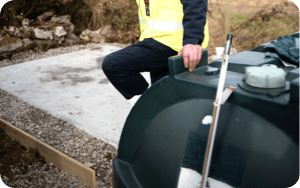Would you know how to bleed your oil boiler if required? Or the reasons why you might have to? There are two key situations where you would need to bleed your oil boiler, including:
- If you run out of fuel: Air can get trapped in the fuel line which can stop it from working.
- To adjust your oil boiler pressure: If your boiler pressure is too high or low, your boiler may lockout.
In this helpful guide, we’ll explain the process of safely bleeding and restarting your heating system for both scenarios.
1. What happens if you run out of heating oil?
Failing to top up your oil tank with kerosene or gas oil can result in running empty. An empty tank may leave you without heating and hot water.
On a positive note, oil furnaces have mechanisms built into them which will automatically switch off if there is no oil to combust. This means beyond any discomfort a lack of fuel won’t cause any safety problems, but you will have to take some key steps. You’ll need to:
- Refill your tank with heating fuel oil.
- Bleed any excess air from your system.
- Reset your boiler to get your heating system back up and running.
You could also encounter some problems that can affect your boiler and require action:
A dry tank can draw dirt and reside into the fuel line
Letting your fuel tank run dry can lead to residue in the fuel line. The dirt that often collects at the bottom of your oil container will be drawn into the fuel line.
If your boiler becomes clogged with residue, you will need an OFTEC registered engineer to clean your fuel lines or replace your filter. Avoid this added expense by keeping your tank topped up.
Air may become trapped in the fuel line of an empty oil tank
If you have an empty tank and the boiler no longer works when you press the reset button, there may be air in the fuel line. This means you’ll need to bleed your fuel supply system to remove the air.
Top Tip: Avoid running out of heating oil by keeping track of how much oil you’re using. Read our handy guide to measuring your oil usage.
Instructions for how to bleed an oil fired boiler with trapped air:
You can bleed an oil boiler system by yourself in a few simple steps. But if you’re unsure or don’t feel confident, call an OFTEC registered technician.
What equipment do you need for bleeding trapped air from an oil boiler?
Before you begin to bleed air from the system and you want to do this yourself, you’ll need some basic equipment.
- A pipe wrench or an Allen key.
- A small container.
- Rubber gloves and rags to mop up any spillages and to keep mess to a minimum.
How long does it take to bleed an oil boiler?
The process of bleeding an oil boiler takes roughly five minutes.
Step-by-step guide to bleeding trapped air from your oil boiler:
- Make sure your boiler is turned off.
- Take the front cover off your appliance and find the bleeder valve/screw on the fuel pump.You’ll find this near to where the oil line comes in.
- Place a small container underneath this bleed screw ready to catch the oil as you drain the line.
- Loosen the bleed screw using your wrench or Allen key. Loosen the screw gradually, and only loosen it part way. If you remove the screw completely, oil will come spurting out at high pressure, leaving you with a nasty spillage to deal with.
- Once the screw is sufficiently loose, push the reset button on your boiler. Keep your wrench or Allen key on the screw ready to tighten it back up.
- Listen out for a hissing sound as air escapes. The hissing will be followed by a sputtering of oil mixed with air.
- After the initial air has escaped, you should see a steady flow of oil.
- As soon as you get a steady flow, tighten the screw and make sure to fasten it securely.
Points to be aware of during the process
You may find your boiler reset cycle finishes before the air is drained from your fuel line. If this happens, you’ll need to press the reset button again to continue the process until the trapped air is completely clear.
How to restart a boiler after running out of heating oil
Restarting your oil boiler after you’ve run out of fuel could be as simple as pressing a button. However it may also be a little more complicated.
Don’t rush the restart process
If you have an old metal tank, wait for a couple of hours between your fuel delivery and attempting to fire up your boiler. Allow time for any tank sludge to settle before you restart your appliance. Hurrying the process risks damaging your system. We always recommend reading your oil boiler manual and tank instructions if you’re ever unsure.
Once you’re confident that the fuel has settled in your tank, try to switch your boiler back on using the reset button. Hopefully, your appliance will simply kick into action straight away and start heating your home normally.
If air is trapped in the supply line, your boiler may be unresponsive. Don’t keep pressing the reset button as this isn’t good for your boiler.
2. What if the pressure in my oil boiler is too high or low?
Apart from running out of oil, there are other things that can prevent your boiler from operating properly. One of these is incorrect pressure.
What pressure should my oil boiler be?
The optimum pressure for oil boilers differs from model to model. Consult your manual if you’re not sure whether your boiler is operating at the proper pressure. Manufacturers generally recommend between one and three bars, often pointing to around 1.3 bars as ideal. The priority is to steer clear of the red zone on your boiler pressure gauge.
If your boiler pressure is too high or low, it may lockout. Checking your boiler regularly can help to prevent issues. You can adjust your boiler pressure yourself, or contact an OFTEC registered technician to fix the issue.
How can I adjust the pressure on my oil boiler?
If your boiler pressure is too high, you’ll need to bleed water from the system. The process will be much easier if you have someone helping you.
Oil boiler bleeding instructions for reducing pressure:
- Locate the drain cock or a radiator bleed valve.
- Loosen the valve slightly to allow water to escape slowly. Do this until the pressure reaches the recommended level. While one person releases water, the other can monitor the pressure reading on the boiler.
What to do if your boiler pressure is too low:
If the pressure is too low, you’ll need to add more water to the system. You can do this by:
- Opening the valve on the external filling loop (you can find this below the boiler casing).
- If this becomes unclear, your instruction manual should explain the process in greater detail for your model.
Whether you’re bleeding air from your fuel line or repressuring your oil boiler, you should only attempt these fixes if you’re confident that you know what you’re doing. If you’re not, ask an OFTEC registered heating engineer to look at your appliance.
If you need help with your oil boiler, please contact our experts.
Alternatively, get a quote for your heating oil delivery today.





